Category — ageism
Seasons of life. Not.
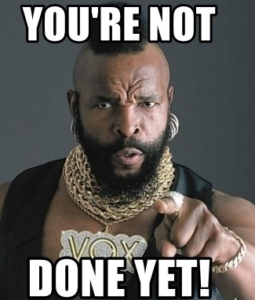
This one isn’t about the Camino.
Or maybe it is. Ever since I returned from that 36-day trek across northern Spain, it seems that everything, somehow, is tied to that experience, from my restlessness when a day goes by without a hard hike to my obsession with pimientos de padron, from my habit of waking before dawn to the vitality I feel as I explore a new relationship.
“I’m not done yet” is what I said to myself—and out loud—when I returned. Treading water is comfortable when the water is warm, and you have learned to tread like a champ. And when it’s been so long since you’ve cast out into deeper waters that you have forgotten the thrill and joy of that. Processing—loss, tragedy, grief, the everyday cruelties–is important and necessary work, and it takes time. But like a blender left churning for too long, one can over-process. Life shouldn’t be smooth and creamy. You should be able to taste it all, each flavor, each texture, distinct. Even the bitterness. Even the chunks.
And so you (and by you, I mean I) say “I’m not done yet” and you move back into the world. You stride, in fact. Which brings me to the point of this little essay, a controlled rant against the “seasons of life” premise.
You know how it goes: Spring is youth, hope, new beginnings. Summer is growth and abundance. Fall is taking stock, slowing down, beginning to feel the chill. Winter is bleak, all sadness, heartbreak, loneliness. We buy into this as the expected phases of our lives. Our culture buys into this in a big way–an appallingly ageist and ignorant way–that hurts the young and the old and the in-between.
Our own experience often contradicts these clichéd seasons: A troubled youth that is anything but hopeful. A summer of “abundance” (careers, acquisitions) that costs us dearly. And an autumn that is so full of hope it takes our breath away. Speaking for myself, it is fall. I am supposed to be in the Autumn of My life. I am supposed to measure my steps, temper my ambitions. I am supposed to feel a chill in the air.
To which I say: NOPE. I am not treading water. I am not moving cautiously. I AM NOT DONE YET.
And don’t get me started on winter. It is the season of boots and soup and snowshoes. The season where strong, graceful, leafless trees reveal their true beauty. Bring it on. Just not yet.
About Mr. T. My favorite character on the A Team. Yes, I watched that show. Also the name of my ferocious rooster who protected the hens from raccoons when he wasn’t otherwise engaged mounting them.
March 1, 2023 2 Comments
The exception(s) that DISPROVE the rule
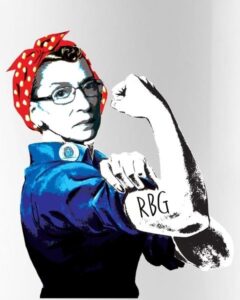
When are there so many “exceptions that prove the rule” that the rule itself is negated? How many “exceptions” does it take for the rule to become obsolete, for us to forever forget the damned rule?
I am thinking of Ruth Bader Ginsberg here. I am thinking of Georgia O’Keefe. Toni Morrison. Beverly Cleary. Sadie Delany. Oh, for goodness sake, Betty White. I am thinking of all these “exceptions that prove the rule,” these old women who are/were strong, vital, spirited, energetic, resilient, creative, interesting. The “rule” they are/were all exceptions to? It’s the rule that states to be old means to be sickly, fragile, dependent, boring–and useless. And in the way.
Yeah, yeah, Bernie mounted the most energetic campaign possibly in the history of campaigning at age 74. And Grandma Moses didn’t start painting seriously until she was 78. And sure, Ruth is rocking it on the bench at 87. But whenever we hear about active, engaged, powerful people who are 75 or 80 or, gasp, even older, they are presented as exceptions. Because everyone knows that old people are creaky, crabby creatures who totter around (if they’re lucky), eat bland mushy food, natter on about their ailments, and hold up the line at the grocery store by writing checks. Checks.
Among the countless things that anger (stun, depress, disgust, worry) me these days is institutionalized ageism. Yes, I said ageism. Not racism, sexism, homophobia. Well, of course racism, sexism, homophobia. But those -isms and –phobias are at least part of our national conversation. We protest in the streets about them. We attempt (sometimes successfully) to create policies that weaken their hold. They are discussed in schools, in the media, on the lecture circuit. I am not saying we have come close to conquering these forms of discrimination. I am saying we are talking about them.
And then there’s ageism.
It is not just firmly embedded in popular culture. It is mostly invisible–thanks to the imposed and self-imposed ghettoization of the elderly (from nursing homes to upscale retirement “communities”).
The old stereotype is accepted virtually without question. Haha. Read the funny birthday cards about clueless, forgetful old people. The memes. The street signs that show us what we think: A silhouette of a stooped (oh that dowager’s hump) old lady grasping a cane. She can hardly place one foot ahead of another. Watch her struggle as she totters, oh-so-slowly, across the street.
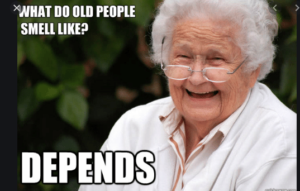
And then there’s Ruth. And Toni. And Betty. You know, the “exceptions.”
As George Bernard Shaw famously wrote: We do not stop playing because we grow old; we grow old because we stop playing. (He lived to age 94.)
Ruth is in the game. She is a player. She is, in fact, the hands-down winner of the MVP award.
She is brave and honorable. She is persistent and tireless. Let’s honor her by NOT calling her “the exception that proves the rule.” Let’s trash the rule.
Here’s what I wrote a while ago about old people in Europe, where old people are part of the life of their communities.
August 19, 2020 2 Comments
Old. Dead.
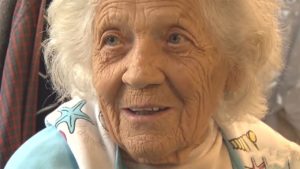
About a fifth of U.S. virus deaths are linked to long-term care facilities for the elderly.
Nursing homes are, in the words of one health official, “death pits.” (You may recall, in a previous post, I quoted another health official calling prisons in the time of covid, “petri dishes.”)
The news from nursing homes, assisted living and memory care facilities, and other places where the sick and the elderly are housed is grim. As the New York Times reports: 72 long-term care facilities in New York have had five or more deaths; infections have broken out in 394 long-term care facilities in New Jersey; 24 people at a facility in Maryland have died; more than 100 residents and workers have been infected at another in Kansas; and people have died in centers for elderly military veterans in Florida, Nevada, New York, Maine, Massachusetts, Oregon and Washington.
There’s a lot to untangle about this.
One obvious thing: This virus, like pretty much any disease, takes hold among vulnerable, medically compromised people. Healthy older people (of which there are millions) don’t live in assisted living. Frail and fragile older people do. Contagious diseases of all kinds make their way through these places quickly and devastatingly. So there’s that.
There’s also the way these places are designed. I’m not talking about the estate-like, private-apartment, gated-community housing for the wealthy (healthy) elderly. I’m talking about small, confined settings like nursing homes and memory care facilities where people live sometimes two to a room, where they sit together in small common areas all day, eat together clustered at tables. There is no social distancing. These places are not constructed in a way that makes that possible.
But there’s something else at work here, not so far beneath the surface.
First: THIS IS HOW WE TREAT OLDER PEOPLE in our culture. We warehouse them. We create confined, segregated spaces for them. And we don’t pay attention unless something terrible happens in those confined spaces.
And, we do this, we warehouse our elderly, because of our attitudes toward aging and the aged: They are useless. They are a drain. They are in the way.
And the warehouses we create are breeding grounds for disease not just because of how they are constructed but also because of how we treat the people who work at these facilities.
I know. I worked at an Alzheimer’s care facility for four months. My minimum-wage job did not include insurance (no surprise there). But it also did not include any provision for sick days. It was not just that there were no paid sick days. It was that sick days were NOT ALLOWED. If you were ill, you had the responsibility of finding a replacement. If you didn’t find someone to cover your shift, you risked being fired. If this happened twice, you were fired.
But mostly, if you were sick, you came in to work. You could not afford to stay home. Many women I worked with chose employment at this particular facility because it was on a bus line. They could not afford a working automobile. Or gas if they had one. Many were on food assistance even though they worked fulltime. That’s how we value the people who care for our sick elderly. Because that’s how we value our elderly.
This pandemic with its death toll challenges us, compels us to examine our attitudes toward the elderly, how we treat them and how we treat those who care for this. Let some good come of this.
*image is not of a person who died. I chose this because I wanted us to LOOK at the face of the elderly.
April 22, 2020 No Comments
Spare me the ageist bullshit
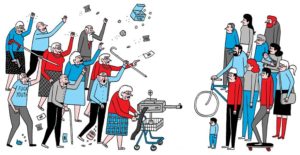
I am weary weary weary of ageism, from the I’ve fallen and I can’t get up stereotype of the frail, helpless older person to the gee-whiz look at this older person actually doing something stereotype of exceptionalism.
Now comes more ageism coupled with the current let’s find more ways to sow division among ourselves zeitgeist. In addition to (abbreviated list here) race, class, sex, gender identity, religion, geography, how about let’s plant and water and nourish the seeds of a deep generational divide. Yeah, let’s do that.
So, my fellow Democrats, we are hearing this incessant drumbeat: Bernie is supported by the young and not the old. If he wins it will be the triumph of the young people over the old people. The young are progressive and open-minded, and the old are…not.
But WAIT. Bernie is old!
And, hold on there, the older generation (dismissed lately with “Okay, Boomer..”)—tens of millions of women and men born into that generation—were the heart and soul of the many social justice and reform movements of the 60s and 70s: second-wave feminism, reproductive rights, gay rights, Black power/ empowerment, environmental action, student rights, anti-war, free medical clinics, alternative schools. The democratic socialist ideals and principles that Bernie stands for were (and continue to be) embraced by millions in this older generation. Of which he is but one example.
So, please, don’t tell me Millennials have a lock on progressive ideals and policies. Please don’t tell me the older generation is not just frail and feeble and helpless and sexless–but (gasp) conservative as well. Please don’t divide us.
Because you know who will conquer.
Oh, and by the way, as a committed and enthusiastic supporter of Bernie’s ideas, I am a Warren woman. Her politics mirror Bernie’s, but I think she’s smarter and more thoughtful. And she doesn’t constantly stab her finger at you when she talks.
February 26, 2020 4 Comments
Keep It Moving
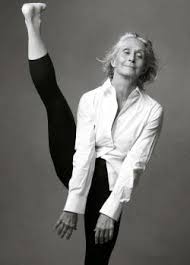
Keep It Moving is Twyla Tharp’s newest book. Nearing 80, vibrant and productive, a creative tornado, a no-nonsense powerhouse, she ruminates on how to live with purpose as time passes.
After the first chapter, gloriously and emboldenly entitled “Take Up Space,” the book devolves into mostly standard generic self-help advice (e.g. take care of your body, take risks, build resilience, etc.). But because it is coming from Twyla Tharp, a woman of enormous energy and extraordinary vitality, it feels authentic (not to mention hard-won), imbued with a deep wisdom—and an engagingly stern attitude—missing from other such “literature” like those perky women’s magazine columns or those mountains of follow-this-fad books.
But it is not the nothing-new-here advice, or the little exercises (I don’t mean push-ups) she offers that has stayed with me, that I want to pass along to you. It is these statements.
To look back is to cling to something well over and behind you. We don’t lose youth. Youth stays put. We move on.
Age is not the enemy. Stagnation is the enemy. Complacency is the enemy. Stasis is the enemy.
Choose to make your life bigger. Opt for expression over observation, action instead of passivity, risk over safety, the unknown over the familiar. Be deliberate. Act with intention.
Evaluate your accomplishments as beginnings rather than endings.
And finally:
Bend in the wind.
Get stronger for the mending.
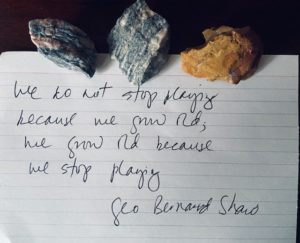
January 15, 2020 No Comments
We are volunteers of America
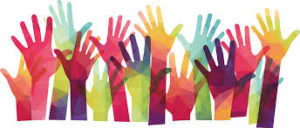
The men and women sitting in a circle at the Friends’ Meeting Hall in Salem. The men and women sitting in a circle in the First Methodist Church in Eugene. They’ve come to listen to me share what I’ve learned about those who live their lives behind bars. They’ve come to talk about the morality of punishment and the promise of restorative justice. They’ve come to talk about whether and how people can change, about whether and how we can forgive.
I am so happy to get these invitations to speak, so happy to be part of these discussions that center on—but go so much farther than—the work I do at Oregon State Penitentiary, the book that came from that work, and the men who have taught me so much.
What makes me happiest is being in the presence of these people, many of whom have given and continue to give their time and energy as volunteers. Some have experience volunteering in jails and prison. Many volunteer at local food banks or for Meals on Wheels. Some volunteer in schools, in libraries. Many have long histories of involvement in social justice movements.
It feels good to be in their midst. It feels especially good to be surrounded (literally) by generous, open-hearted folks at a time when it is too easy to feel there are no generous, open-hearted folks. Too easy to buy into the narrative that we all distrust and hate each other. That we wish each other ill. That we are greedy and selfish.
We are not.
According to the Bureau of Labor Statistics data, 25.3 percent of Americans volunteer, which is 62.8 million volunteers.
Who volunteers? The groups gathered in the circles at the two church events were mostly older people. That’s who goes to church these days. But volunteers tend to be exactly who you would think would have no time to volunteer: married women with children under the age of 18. Working women. According to the latest survey data, the largest age group for volunteers was 35-44. Women out-volunteered men 27.8 percent to 21.8 percent
That said, more than a quarter of people older than 55 are volunteers. So, while you are erasing the image of a country filled with people who hate each other, please also erase the damaging, insulting and erroneous image of older people doing nothing other than taking up space.
.
Oh, and guess which mid-sized cities are in the top 20 in the U.S. for rates of volunteerism? Portland (38.4 percent) and Eugene (33.9 percent). Salem is not far behind, at #29 (29.9 percent).
October 2, 2019 No Comments
Seriously? Still?
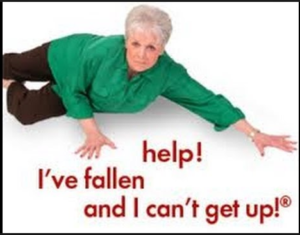
On the big TV screen in the gym where I work out, I see an ad. It features a stooped over old lady pushing a mail cart through the hallways of an office. She squints, trying to make out the address on a package. She totters, loses her balance, leans heavily on a cane. In the next scene there’s a flabby old guy dressed in a firefighter uniform holding a hose. Or trying to. He can’t control it. It whips him around. He falls.
Now comes the voice-over. We learn that these helpless, doddering old people have to work—and look at how poorly they do it!– because they didn’t save for their retirement. That message—it is a good idea to plan ahead and put something by for the future—is a good one. But the presentation is pure, unadulterated ageism.
And I am sick of it.
No, not sick: Angry. Infuriated.
At the moment I am awaiting a visit from the construction manager of a reno project we just finished at our house. He didn’t just “manage” the four-month project, he demoed walls, moved furniture, installed cabinets, hefted new windows, got down on his hands and knees and investigated crawl spaces. He is 67.
In fact, about a quarter of men and women over 65 are in the workforce. Presumably, they are performing the duties of their jobs without falling over.
Every Wednesday I go to Food for Lane County’s Dining Room where I join a group of a dozen volunteers. Some of us wait tables and carry trays and serve coffee, walking a mile or two during our shift. Others heft big dessert trays, bus tables, scrub pots and pans. These men and women are in their 60s and 70s. We have several octogenarian volunteers, and there’s one 92-year-old woman who works regularly in the kitchen. These folks bring energy and vitality to this work. They are healthy and active.
In fact, 80 percent of people over 65 report that their health is ”fine” or better.
So why are all these folks and the millions of others like them—and do I need to invoke the name RUTH BADER GINSBURG?—considered exceptions to the rule? Why does the rule still stand? Why is the rule that older people are helpless, hapless, frail, sickly, useless, tired and tiresome, boring—and in the way?
Seriously, FUCK THAT SHIT.
December 5, 2018 No Comments
Thank you, Emma
Emma Gatewood was the first woman to hike the entire Appalachian Trail (2,168 miles). If you read about her, the first thing you’ll read is that she was 67 at the time, and then, because she’s a woman, you will read about how many children and grandchildren she had.
But here’s the most startling thing about Emma Gatewood’s 1955 trek: She wore Converse sneakers and carried an army blanket, a raincoat, and a plastic shower curtain in a homemade denim bag slung over one shoulder. That’s how she hiked. Damn.
At this very moment, a year from now, I will be hiking the Oregon section of the PCT, all 460 miles of it, from the Siskiyou Summit north across the crest of the Cascades to the Columbia River. I hesitated with the verb tense in the previous sentence. I will be. I considered writing “I might be” or “I hope to be” or some other waffle-ly statement. But I want to declare this intention without wiggle room.
I made the declaration to myself yesterday as I trudged up our access road for my first practice hike, a five-miler over to and up Spencer Butte with a lightly loaded pack. I’ve hiked a lot, including some tough backcountry day hikes in the Kootenays of British Columbia and the red rock country of southern Utah. The operative word there is day hikes.
I have only once in my life hiked, camped and then hiked some more, and that was back before the invention of moveable type. On my various day hikes since that time, I’ve never carried more than one of those little Camelback hydration packs. Yesterday I hoisted on, cinched in, buckled up, etc. a serious through-hike backpack, one of several pieces of gram-shaving high-tech equipment I’ve been acquiring.
I plan to hike only the Oregon section – a third of Emma’s mileage – and I plan to outfit myself with ultra-light gear that will not include shower curtains.
Why the Oregon section? It’s my homage to the state I fell in love with at first sight, the state that’s been my home for pretty much all of my adult life, the state that continues to leave me breathless with its beauty (and generally the politics ain’t bad either). Also, hiking the entire PCT takes more than 5 months. The Oregon section… maybe 5 weeks. Note that one of my reasons is NOT “I couldn’t possibly hike the entire PCT.” Maybe I could. Maybe I couldn’t. After I complete the Oregon section, I’ll know better.
Why do this at all?
To see if I can.
Because of Emma Gatewood.
And because, as Gandhi famously said: “You must be the change you want to see in the world.” And I want to see the end of ageism.
July 11, 2018 No Comments
Becoming inVISIBLE
A few nights ago I suffered through one of those seemingly interminable, low-level stress dreams that sometimes afflict me. This one was about losing my purse. I was standing at a counter picking up tickets for a performance of (you guessed it!) The Nutcracker. I placed my purse on the counter and momentarily forgot about it while involved in the ticket transaction. When I looked over, it was gone. Thus ensued a long, boring, stressful search for purse. After watching me hunt high and low, an employee told me he removed the purse from the counter and put it under a desk. Great, I said. Thanks.
But the employee did not want to give me back my purse until I “proved” it was mine. I had to detail for him, quite precisely, various items in the purse. I would tell him one thing—my key chain—and he’d then ask for another. My Snap Fitness entry card. My packet of g.u.m soft-piks. My ear buds (What brand? he asked. I didn’t know. He frowned.) My Swiss Army knife. What else? What else? This went on for a long time. Finally he let me have my purse. End of dream.
I thought about the dream a lot during the day. It could be just a generic stress dream. But the more I thought about how it felt to have to prove that what was mine was mine, the less generic and more meaningful the dream became.
The meaning? Here goes:
It seems to me that I am now at a point in my life when I shouldn’t be required (or forced) to “prove” my identity, or prove my own worth to others (like the guy in the dream). I have grown into who I am. I have spent a number of decades growing and learning and doing what I do. When I was younger, a bright young penny who knew so little, who understood so little, I was noticed, and the light shone down upon me. Now, knowing so much more, having done and lived and learned so much more, I join the ranks of the Invisible and the Overlooked, the ones — we “older” women — who have to prove we still have it. About whom it is assumed that we have settled into complacency, that we do not burn with creativity and passion, that we are not ignited by new ideas, that we are no longer vital and vibrant and alive.
Guess what, you overlookers, you nay-sayers who put up barriers, you sexist ageist assholes (and especially those who pretend they aren’t)? You couldn’t be more wrong.
And also: FUCK YOU.
December 6, 2017 4 Comments
Ageism. Again.
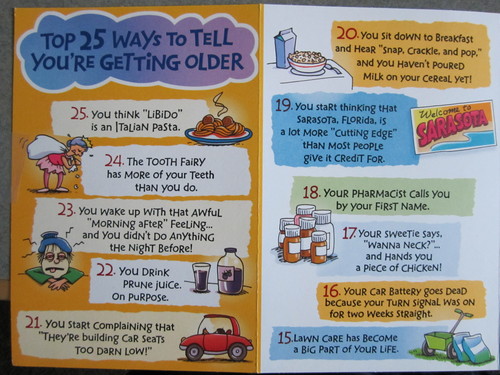 It’s time to rant again about ageism.
It’s time to rant again about ageism.
This time, however, it’s not about those offensive intersection crossing signs that feature stooped over, cane-holding old ladies or those offensive birthday cards like the one for 50 — yes, 50 — “remember that ill-advised sleeve tattoo you got during your misspent youth? Think how it looks to your doctor while you sit in his office complaining of incontinence” or those offensive ads targeting clueless, brain-fogged old people who cannot seem to manage the intricacies of a normal cellphone.
Nope, this is about how older people are sometimes complicit in the creation and maintenance of these stereotypes. (In fact, as I wrote in Counterclockwise several years ago, unlike just about every other group on the receiving end of an –ism, a disturbing majority of older people actually believe the damaging stereotypes about older people.)
This was a video clip that came across my morning updates yesterday, a CNN story about “beating loneliness after retirement.” The story is about these old guys who don’t know what to do with themselves after retirement. Fair enough. So they go bowling. Now I love bowling. Nothing against bowling. But here is how one of the guys described his decision to join in: “It was either this or sit on the couch all day and watch TV.”
Seriously? That’s the choice?
If you have the energy and strength to go bowling (and yay for that), then you have the energy and strength to be a mentor to a kid who needs an adult in his life. You have the energy and strength to volunteer at your local food bank. To hammer a few nails for Habitat for Humanity. To go play with dogs in animal shelters. To tutor adults who can’t read.
To be visible and useful and show that you are a caring, contributing part of the community in which you live. Otherwise, you actively contribute to the stereotype of older people as useless. In the way. Just taking up space. And resources.
End of rant. For now.
Oh, P.S. Can I just say/ shout/ proclaim on high:
RUTH BADER GINSBURG
May 24, 2017 1 Comment







